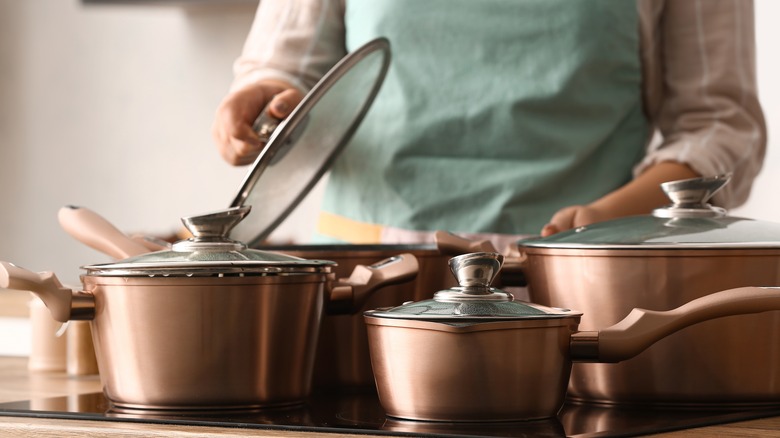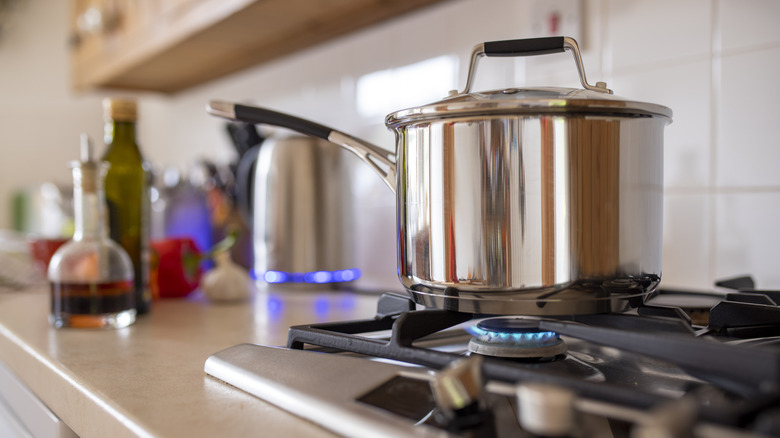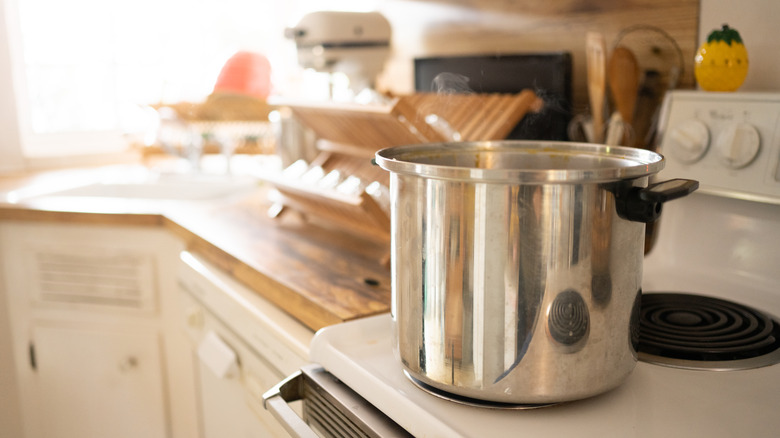No, Saucepans And Pots Are Not The Same Thing
Home cooks can easily become overwhelmed with the amount of equipment we're expected to own and use semi-regularly — different kinds of knives, spoons, spatulas, and sheet pans just to name a few. But cookware sets, even something as seemingly-simple as pots and pans, can cause a surprising amount of confusion. Between a stockpot, sauce pot, saucepan, Dutch oven, and sauté pan, it's difficult to know what to use and when, or how to get the best out of your pots and pans.
Compare saucepans and pots, for example. They're two of the most basic items in your cookware arsenal and the ones you'll probably get a lot of use out of. Are there really that many differences between them? Perhaps one is taller and larger than the other, and one has a longer handle. Surely you could do the same job in either one and it would all come out just the same, right? The answer is no, not ideally. They're each designed with specific cooking tasks and needs in mind, from the way they carry heat, to the volume they hold, to how often they're on and off the stove or in the oven.
Saucepans are one of the most useful pots in your kitchen
Your saucepan — the one with tall sides and a long handle — is probably one of the most versatile pans you have at your disposal. The best saucepans have tall sides and a narrow base, which make them ideal for creating sauces that need to be reduced because the heat carries up the tall sides, so sauces reduce faster. They can come in different sizes, from two quarts up to seven. A saucier pan is a particular type of saucepan with shorter sides and a rounded bottom. The rounded bottom means you can use a whisk and not have to worry too much about your roux hiding in the corners, and the long handle allows you to easily take the pan on or off the heat, as necessary.
While the best use for a saucepan is literally in the name, you can do so much more with it. If it's just you and your bestie, you can use a saucepan to do pretty much anything you'll need. You can make manageable quantities of soup, stew, or mashed potatoes without having to drag out a huge pot. It's also perfect for cooking beans and grains, or even poaching an egg. For most day-to-day applications, it's an ideal tool for the job. Gordon Ramsay even uses one to make his unique scrambled egg recipe, and if it's good enough for him, well, it's good enough for us, too.
Stockpots and Dutch ovens are the kitchen workhorses
Pots are generally larger, probably the largest cooking vessel you have in your kitchen. There are a few different kinds of pots, such as stock pots and Dutch ovens, and they all have their own uses.
Stock pots are taller than they are wide, and have two handles instead of one long one. A stock pot can hold anywhere from eight to 20 quarts, but for home cooking you probably only need a 12-quart stock pot. These gigantic pots are ideal for your bigger projects, like Sunday gravy or sauce, or a large quantity of soup or stew. They're also great for making stocks and broths — some can fit a whole chicken and still leave room for aromatics and water.
Dutch ovens can go from stovetop to oven and back without a problem. These are heavy, and usually made of enameled cast iron, which means they can maintain temperature. They can be quite pricey, but if you get a good one, it's an investment. If well-made and maintained, they should last long enough to pass down to your grandchildren. They're ideal for anything from browning, braising, sauce- and soup-making, to baking bread.
Knowing which pot and pan you need will come with practice, but keep in mind the truth about expensive pots and pans — you get what you pay for, and if you're using quality pieces and treating them well, they'll last a long time.


